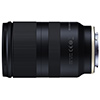
My past Gear of the Year choices - the Nikon D750, DJI Mavic Pro and Sony a9 - were based on the strong emotional connection I made with each, as a photographer and videographer during the given year.
This year I've picked the Tamron 28-75mm F2. 8, a lens I've recommended more than any other in 2018 and one Sony desperately needed for its system.
It's the first third-party zoom for Sony E-mount to offer autofocus and it plays nice with all AF modes; even Eye-AF. It's also the piece of gear in the DPReview cupboard I'm most excited to get out and shoot with once Seattle's weather turns.
The Tamron 28-75mm F2. 8 is a lens I've recommended more than any other in 2018
Last year's pick, the a9, was an admission that I've finally come around to enjoying Sony's cameras. But for me as a reviewer, a camera brand is only as good as its best budget lens options. In my opinion, Sony (in common with quite a few other brands) has done a poor job ensuring budding photographers on a tight budget have access to affordable, fast zooms.
Belvedere clearly likes the 28-75mm.
ISO 5000 | 1/500 sec | F4 | 28mm
At $800, the 28-75mm F2. 8 isn't exactly cheap, but it does offer a-single-lens-solution to new E-mount customers and is a great companion to the a7 III - for about $2800 total, you've got a killer combo. It also makes Sony's own 24-70mm F4, which costs about the same, seem irrelevant.
But the price is not the only thing Tamron got right: it nailed the size and weight, too. Sony's F2. 8 zooms tend to be large and heavy: the $2200 24-70mm F2. 8, for instance, weighs 886g, compared to 550g in the Tamron. Size-wise, the Tamron is also much smaller, about the same size as a can of soda pop (until you zoom, that is).
It offers good center sharpness throughout its zoom range and for most photographers, that's what counts
And just because it's priced a lot lower than comparable native glass doesn't mean it's built with a 'budget' mindset. Sure, the body is made of polycarbonate, but it feels and handles like a high-quality piece of gear. It also well-suited to take on the elements: a fluorine coating on the front repels grime and a moisture-resistant construction, including gaskets around the barrel and at the mount, keeps water out.
It can also handle both stills and video capture as well as Sony's modern full-frame cameras. A 'Rapid eXtra-silent stepping Drive' - the RXD at the end of its name - is virtually silent, ensuring accurate focus with no unwanted focus motor sounds in your videos.
It's the most sensible zoom currently available for E-mount
Now some will argue Sony's heavier, pricier lenses offer sharper results, nicer bokeh, etc. , and honestly, this might be true. But who cares? The Tamron offers good central sharpness throughout its zoom range and for most photographers, that's what counts. Those who want to spend 3x the cash on Sony's version can go right ahead, while the rest of us use the Tamron.
The 28-75mm isn't stabilized but Sony mirrorless cameras are.
ISO 2000 | 1/60 sec | F5. 6 | 55mm
The Tamron 28-75mm F2. 8 my choice for 2018 Gear of the Year because it is a wonderful solution to a problem Sony has long had: the lack of a fast, affordable zoom full-frame zoom. For years, Tamron has concentrated on producing lenses that fill gaps in the market and this might be its most successful to date - there's a reason it was back-ordered months after its launch.
Ultimately, it's a lens for the many, not the few and in this writer's opinion, the most sensible zoom currently available for E-mount.
. dpreview.com2018-12-25 17:00








